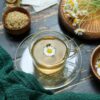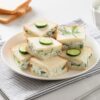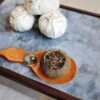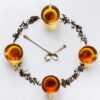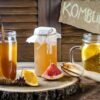
Xinhui Mandarins are a special variety of mandarin oranges that are cultivated in the Xinhui district of Jiangmen city in Guangdong province, China. Known for their thin skin and rich aroma, these mandarins have been a prized fruit in China for centuries. However, their role in tea culture is what makes them stand out on the international stage. Tea oranges, a product made by combining these mandarins with tea leaves, have become a symbol of sophisticated tea consumption and a treasured delicacy among connoisseurs.
Tea oranges, specifically, are an innovative way to enjoy tea that infuses the citrusy zest of Xinhui Mandarins with the earthy tones of puer tea. This unique combination has given rise to a tea experience that is both aromatic and flavorful, offering a multisensory pleasure that has captured the hearts of many tea lovers around the world.
Delving into the world of Xinhui Mandarins and tea oranges not only offers insight into a rich cultural tradition but also introduces a novel way to appreciate the subtleties of tea. In this article, we will explore the depths of this tradition, the intricate process of making stuffed tea oranges, and the impact it has had on tea culture globally.
What are stuffed tea oranges?
Stuffed tea oranges are a unique tea preparation that involves hollowing out Xinhui Mandarins and filling them with puer tea leaves. The result is a compact, fragrant sphere that combines the refreshing notes of citrus with the deep, complex flavors of puer tea. The tea is not only flavored by the mandarin peel but also protected by it, as the peel serves as a natural container that preserves the tea’s quality and enhances its taste during the aging process.
The preparation of these tea oranges is an art form that requires skill and patience. The process begins with selecting the finest Xinhui Mandarins, which are known for their high essential oil content and strong fragrance. The mandarins are then carefully hollowed out, leaving just enough of the pith to maintain the integrity of the peel. Once prepared, the hollowed-out citrus is filled with loose puer tea leaves, which are then allowed to mature within the peel.
The resulting stuffed tea oranges are not just a beverage but an experience. When brewed, the tea takes on a unique flavor profile that is enriched by the mingling of the mandarin’s essential oils and the fermented tea leaves. This innovative form of tea preparation is a testament to the creativity and tradition of Chinese tea culture.
The history of Xinhui Mandarins in tea culture
The history of Xinhui Mandarins in tea culture is a fascinating journey that dates back to the Qing Dynasty. It was during this period that the people of the Xinhui district discovered the harmonious relationship between the aromatic properties of their local mandarins and the robust flavors of puer tea. This discovery led to the creation of stuffed tea oranges, which quickly became a beloved method of enjoying tea in the region.
The practice of combining Xinhui Mandarins with puer tea was originally a local custom, enjoyed by the residents of Jiangmen and the surrounding areas. However, as word of this unique tea preparation spread, it gained popularity beyond the borders of Guangdong province and eventually throughout China. The stuffed tea oranges became synonymous with Xinhui, and the tradition was passed down through generations, with each adding their own touch to the craft.
The significance of Xinhui Mandarins in tea culture is not only historical but also cultural. They represent an innovative approach to tea consumption, one that respects the ancient traditions of tea making while also embracing new methods and flavors. The history of these mandarins in tea culture is a story of both preservation and evolution, illustrating how a regional delicacy can rise to become a global phenomenon.
The process of making stuffed tea oranges
The process of making stuffed tea oranges is an intricate and time-honored craft that demands precision and care. The first step involves selecting the right Xinhui Mandarins, which should be ripe, fragrant, and free of blemishes. Once the mandarins have been chosen, they undergo a meticulous process of preparation, which includes drying and hollowing out the fruit without damaging the peel.
After the mandarins are prepared, they are filled with puer tea leaves. The tea is carefully chosen for its quality and compatibility with the citrus flavors of the mandarin peel. The leaves are gently packed into the hollowed-out fruit, ensuring that there is enough space for the tea to expand during the brewing process.
Once filled, the tea oranges are sealed and left to age. This aging process allows the flavors of the mandarin peel to infuse into the tea, creating a unique and complex taste profile. The length of aging can vary, with some tea oranges maturing for months or even years before they are considered ready for consumption. This careful and deliberate process results in a tea product that is both aromatic and full-bodied, offering a one-of-a-kind tea experience.
Health benefits of tea oranges
Tea oranges are not only valued for their unique taste but also for their potential health benefits. The combination of Xinhui Mandarins and puer tea brings together the nutritional properties of both ingredients, creating a beverage that is rich in antioxidants and vitamins.
The Xinhui Mandarin peel is known to contain compounds such as hesperidin and nobiletin, which are believed to have anti-inflammatory and antioxidant effects. These properties may contribute to the reduction of oxidative stress and the promotion of overall health. Additionally, the vitamin C content of the mandarin peel can help support the immune system and enhance skin health.
Puer tea, on the other hand, is renowned for its digestive benefits and its potential to aid in weight management. The fermentation process that puer tea undergoes results in a tea rich in probiotics, which can promote gut health. Furthermore, puer tea has been studied for its ability to help regulate blood sugar levels and cholesterol, making it a beneficial addition to a healthy diet.
Together, the health benefits of tea oranges are a compelling reason for their inclusion in a wellness-focused lifestyle. Not only do they provide a delightful sensory experience, but they also offer a range of nutritional advantages that can contribute to one’s well-being.
How to properly brew and enjoy tea oranges
Brewing and enjoying puer tea with Xinhui Mandarins is a ritual that accentuates the flavors and aromas of both the tea and the citrus. To properly brew the tea, one must first break off a portion of the stuffed tea orange, being careful to include both the tea leaves and pieces of the mandarin peel.
The brewing process typically involves rinsing the tea leaves with hot water to remove any impurities and awaken the flavors. After the rinse, the leaves are steeped in boiling water for a short duration, allowing the tea to release its full flavor without becoming bitter. The steeping time can be adjusted according to personal preference, with subsequent infusions often revealing different nuances in taste.
To fully enjoy puer tea with Xinhui Mandarins, it’s important to take in the aroma before sipping the tea. The citrus scent complements the earthy puer, creating a harmonious balance that is both invigorating and soothing. As one savors the tea, the interplay of flavors—from the initial burst of citrus to the lingering finish of fermented tea—makes for a captivating and enjoyable tea-drinking experience.
The role of Xinhui Mandarins in enhancing the tea experience
The role of Xinhui Mandarins in enhancing the tea experience can be appreciated on multiple levels. Firstly, the citrusy fragrance of the mandarins adds a new dimension to the aroma profile of the tea, engaging the sense of smell in a way that pure tea alone may not. The scent of the mandarins evokes freshness and can elevate the mood, creating an atmosphere of relaxation and enjoyment.
Secondly, the flavor that Xinhui Mandarins impart to the tea is both distinctive and complementary. The sweet and tangy notes of the citrus blend seamlessly with the depth and richness of puer tea, resulting in a beverage that is complex and satisfying. This combination not only enhances the taste of the tea but also makes it more approachable to those who may be new to the bold flavors of puer.
Lastly, the presentation of tea oranges is visually appealing and adds an element of novelty to the tea-drinking experience. The sight of the small, round tea oranges is intriguing and can spark curiosity and conversation, making the act of drinking tea a shared and communal activity. The role of Xinhui Mandarins in tea culture, therefore, extends beyond taste and aroma; it encompasses the entire sensory and social experience of tea consumption.
The market for tea oranges: pricing, demand, and availability
The market for tea oranges is a dynamic one, influenced by factors such as pricing, demand, and availability. Due to the labor-intensive process of creating stuffed tea oranges and the limited production area for Xinhui Mandarins, these tea products are often considered a luxury item. As such, pricing can vary widely, with some of the more aged or specially crafted tea oranges fetching high prices among collectors and tea aficionados.
Demand for tea oranges has grown as more people around the world become aware of this unique way to enjoy tea. The international interest in tea culture, along with a growing appreciation for artisanal and specialty teas, has led to an increased market for tea oranges outside of China. However, the supply is still predominantly controlled by producers in the Xinhui district, which means availability can be limited, particularly for the highest quality and most sought-after products.
Despite these market challenges, tea oranges continue to find their place among the offerings of specialty tea shops and online retailers. The key for consumers is to find reputable sources that provide authentic and well-crafted tea oranges, ensuring a genuine and enjoyable tea experience.
How to buy and store tea oranges and puer tea
Purchasing and storing tea oranges and puer tea requires knowledge and attention to detail to ensure the quality and longevity of the tea. When buying tea oranges, one should look for reputable vendors who source their products directly from Xinhui producers. It is also important to consider the age of the tea orange, as this can greatly affect the flavor and value of the tea.
Once acquired, storing tea oranges and puer tea properly is critical to preserve their aroma and taste. Tea oranges should be kept in a cool, dry place away from direct sunlight and strong odors. They benefit from proper ventilation, which facilitates the aging process and prevents mold growth. Puer tea, whether stored within a mandarin peel or separately, should be kept in similar conditions, with some enthusiasts opting for specialized storage solutions to maintain an optimal environment for the tea’s maturation.
By following these guidelines, tea enthusiasts can ensure that their tea oranges and puer tea remain fresh and flavorful, ready to be enjoyed at their best.
The future of Xinhui Mandarins in tea culture
The future of Xinhui Mandarins in tea culture looks promising as the appreciation for stuffed tea oranges grows both within China and internationally. As more people discover the unique combination of citrus and tea, the demand for these specialty products is likely to increase, potentially leading to innovations in production and new flavor profiles.
The tradition of using Xinhui Mandarins to enhance the tea experience is a testament to the evolving nature of tea culture. It is a practice that honors the past while embracing the future, ensuring that tea remains a versatile and beloved beverage for generations to come. With continued interest and appreciation, Xinhui Mandarins will undoubtedly maintain their esteemed role in the world of tea, offering a distinctive and enjoyable experience that resonates with tea lovers everywhere.
For those looking to explore the world of tea oranges and the rich flavors they bring to puer tea, there has never been a better time. The fusion of Xinhui Mandarins with tea is a journey worth taking, one that promises to delight the senses and deepen one’s appreciation for the art of tea.

